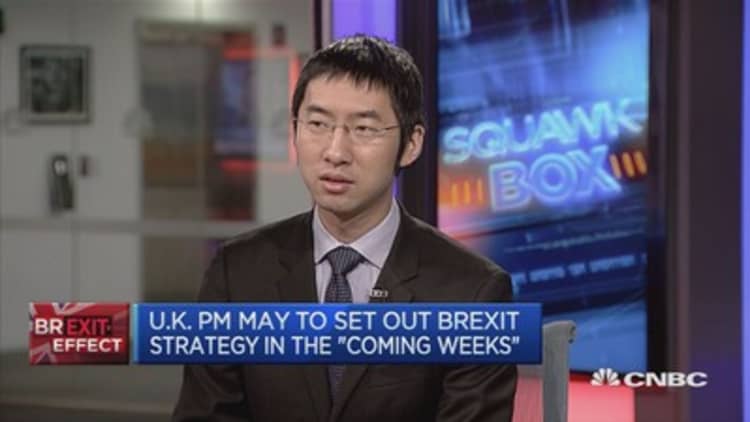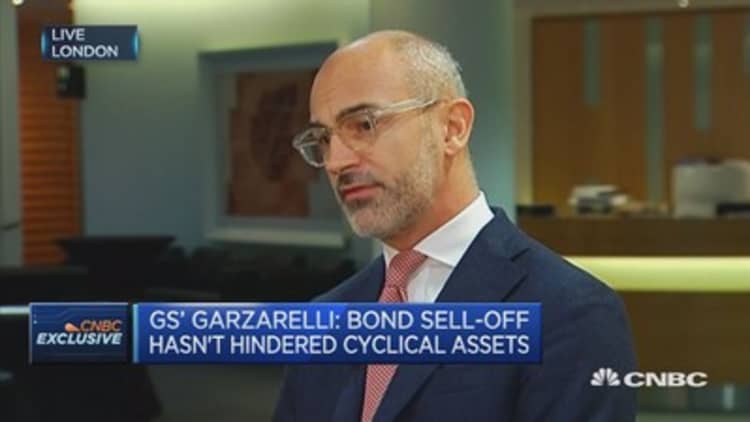
The British pound sank to a two-month low versus the U.S. dollar on Monday morning, hit by both strong labor data out of the United States and comments from the British Prime Minister over the weekend suggesting the U.K. may be on track to leave the European single market.
Sterling broke below 1.22 U.S. dollars at around 6.00 a.m. London time, a level seen as an important support point by foreign exchange traders, reaching lows untested since the final days of October. At around 10:00 a.m. the U.K. currency hits its intraday lowpoint (so far), trading below 1.215 before working its way back up to around 1.217 at 12:25 p.m.
Comments over the weekend during an interview with Sky News from U.K. Prime Minister Theresa May were widely interpreted as confirming that she will prioritize keeping control of immigration in the hands of her government over favoring access to the European single market once the U.K. leaves the European Union (EU). The single market is a tariff-free trade agreement within the EU and is seen as crucial for certain sectors such as car manufacturing.
"Often people talk in terms as if we are leaving the EU but we still want to keep bits of membership of the EU. We're leaving, we're coming out," May stated.
The prime minister also reconfirmed her earlier commitment to trigger the "Article 50" clause which will set in motion the two-year timeline (extendable if agreed by both sides) for the country's exit from the regional trading bloc.

However, the prime minister sounded a different note on Monday morning, with Reuters reporting that May was keen to play down the certitude of a "hard" Brexit.
"I'm tempted to say that the people who are getting it wrong are those who print things saying I'm talking about a hard Brexit, (that) it is absolutely inevitable there's a hard Brexit," she said.
"I don't accept the terms hard and soft Brexit. What we're doing is going to get an ambitious, good and best possible deal for the United Kingdom in terms of ... trading with and operating within the single European market," she continued.
London's critically important financial sector has campaigned hard for continued access to the EU's single market, over elevated fears that key banks and asset managers will relocate staff to the continent if they are no longer able to trade under the existing "passporting" rules which permit business to be carried out across EU member states.
Meanwhile, traders and strategists also pointed to factors encouraging U.S. dollar strength in analyzing Monday morning's movements.
"I still think there is a dollar component there if you compare to a relatively robust reaction to Friday's numbers but on the back of the prime minister's comments," Geoffrey Yu, head of the U.K. investment office at UBS Wealth Management told CNBC's Squawk Box on Monday morning.
"Friday's overall solid monthly jobs report from the U.S. rekindled the 'Trump trade' and lifted the greenback across the board," Haresh Menghani of FXStreet, posited in a blog report.
"The latest reading on the labor market provided evidence of strong wage growth and revived expectations of higher inflation, providing support to the greenback's well-established bullish trajectory," he continued.
Looking ahead, UBS's Yu suggested cautious positioning may be warranted in the lead up to the kick off of Britain's exit timetable.
"You want to be somewhat defensive heading into March. We haven't had any event risk in sterling for quite a while now and we do think that triggering 'Article 50' is probably the next somewhat binary event risk," he outlined.
"If we get it right probably we could see actually a structural upward move but if we do get it wrong then a downward move, but again those would be areas given the valuations where we look at getting back into long sterling again."
In emailed comments to CNBC, Craig Erlam, senior market analyst at OANDA, said the British currency remained extremely vulnerable to the prospect of a raw deal for the U.K. economy and highlighted the next critical levels to watch.
"While we may find further support around 1.2150, the next key level for the pair comes just below 1.21, the post-flash crash lows. This will be a major test of just how bearish sterling traders are in the aftermath of May's comments," he concluded.


